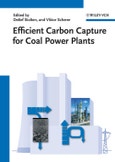Carbon Capture and Storage is a key technology for a sustainable and low carbon economy. This book unites top academic and industry researchers in search for commercial concepts for CCS at coal power ploants. This reference focuses on power plant technology and ways to improve efficiency.
It details the three principal ways of capturing the CO2 produced in power plants: oxyfuel combustion, postcombustion and precombustion, with the main part concentrating on the different approaches to removing carbon dioxide. Wtih an eye on safety, the authors explain how the three parts of the CCS chain work - capture, transport and storage - and how they can be performed safely.
The result is specific insights for process engineers, chemists, physicists and materials engineers in their relevant fields, as well as a sufficiently broad scope to be able to understand the opportunities and implications of the other disciples.
It details the three principal ways of capturing the CO2 produced in power plants: oxyfuel combustion, postcombustion and precombustion, with the main part concentrating on the different approaches to removing carbon dioxide. Wtih an eye on safety, the authors explain how the three parts of the CCS chain work - capture, transport and storage - and how they can be performed safely.
The result is specific insights for process engineers, chemists, physicists and materials engineers in their relevant fields, as well as a sufficiently broad scope to be able to understand the opportunities and implications of the other disciples.
Table of Contents
PrefacePART I: Introduction and Overview
THE CASE FOR CARBON CAPTURE AND STORAGE
Introduction
Dilution versus Treatment
Carbon Reservoirs
Excell Carbon
The Scale of Carbon Capture and Storage
Storage Capacity Requirements
Conclusion
ADVANCED POWER PLANT TECHNOLOGY
Introduction
History of the Development of Power Plants -
Corellation Beween Unit Size, Availability, and Efficiency
Possibilities for Efficiency Increases in the Development of a Steam Power Plant
CAPTURE OPTIONS FOR COAL POWER PLANTS
Introduction
Requirements on CO2 Capture and Compression
CO2 Capture Routes
Gas Separation Tasks and Methods
Plant Concepts for Carbon Capture
Carbon Dioxide Compression
Conclusion
LIFE CYCLE ASSESSMENT FOR POWER PLANTS WITH CCS
Introduction
Life Cycle Assessment as an Assessment Method
Review of Life Cycle Assessments Along the Whole CCS Chain
Results
Constraints of LCA Regarding an Assessment of CCS
Comparison of Electricity from CCS and from Renewable Energies
Conclusion on Needs for Action
PART II: CO2 Scrubbing
PHYSICS AND CHEMISTRY OF ABSORPTION FOR CO2 CAPTURE TO COAL POWER PLANTS
Gas Separation for CO2 Capture
Process Engineering and Performance
Physical Absorption
Chemical Absorption
Physical Properties
Outlook
CHEMICAL ABSORPTION MATERIALS FOR CO2 CAPTURE
Introduction
Alkanolamines
Sodium and Potassium Carbonates
Ammonia
Amino Acid Salts
Ionic Liquids
Conclusion
PHYSICAL ABSORPTION MATERIALS FOR CO2 CAPTURE
Introduction
Pre-Combustion Capture in IGCC
Physical Absorption Materials and Processes
Conclusions and Outlook
CO2 REMOVAL IN COAL POWER PLANTS VIA POST-COMBUSTION WITH ABSORBENTS
Tail-End CO2 Capture
Demonstration Plants and Pilot Plants
Conclusion
CO2 REMOVAL IN COAL POWER PLANTS VIA PRE-COMBUSTION WITH PHYSICAL ABSORBTION
Introduction
The Sorption-Enhanced Water Gas Shift Process
Sorption Processes and Material Development for SEWGS
Conclusion and Outlook
PART III: CO2 Removal with Cryogenic Air Separation
CO2 CAPTURE VIA THE OXYFUEL PROCESS WITH CRYOGENIC AIR SEPARATION
Introduction
Flue Gas Recycle
Combustion
CO2 Purification and Capture
Efficiency
Current Developments
PART IV: Separation with Membranes
PHYSICS OF MEMBRANE SEPARATION OF CO2
Introduction
Macroscopic Mass Transport
Permeation Through Materials
Membrane Geometries and Morphologies
Fluid Dynamics and Modules
Process Design
Conclusion
INORGANIC MEMBRANES FOR CO2 SEPARATION
Introduction
Membranes for Gas Separation
Conclusion and Outlook
POLYMER MEMBRANES FOR CO2 SEPARATION
Introduction
Polymer Membranes for CO2 Capture
Theoretical Gas and Vapor Transport Through Dense Polymer Membranes
Gas and Vapor Transport Through Dense Polymer Membranes for Flue Gas Treatment
Conclusion
CO2 SEPARATION VIA THE POST-COMBUSTION PROCESS WITH MEMBRANES IN COAL POWER PLANTS
Introduction
Process Boundary Conditions
Membranes and Membrane Modeling
Membrane Processes
Economics of Membrane Processes for CO2 Capture
Summary and Conclusions
CO2 SEPARATION VIA THE OXYFUEL PROCESS WITH O2-TRANSPORT MEMBRANES IN COAL POWER PLANTS
Introduction
MIEC Membrane Operating Concepts
Hard Coal Membrane-Based Oxyfuel Process
Literature Review of Membrane-Based Oxyfuel Processes
Towards Realization -
Module Design
Conclusion
CO2 SEPARATION VIA PRE-COMBUSTION UTILIZING MEMBRANES IN COAL POWER PLANTS
Introduction
Process Conditions, Membrane Characteristics, Classification Numbers, Permeation Laws, and Water Gas Shift
Pre-Combustion Concepts with Scrubbing Technologies
Pre-Combustion Concepts with CO2-Selective Membranes
Pre-Combustion Concepts with H2-Selective Membranes
Conclusion
PART V: Chemical Looping for CO2-Separation
CHEMICAL LOOPING MATERIALS FOR CO2 SEPARATION
Introduction
Chemical Looping Combustion of Solid Fuels
Chemical Looping with Oxygen Uncoupling (CLOU)
Chemical Looping Reforming
Chemical Looping Gasification of Solid Fuels
Oxygen Carrier Development
Reactor Design and Operational Experience in Chemical Looping Combustors
Reactivity and Solids Inventory
Conclusion
CHEMICAL LOOPING IN POWER PLANTS
Introduction
Chemical Looping Combustion
Carbonate Looping Process
Conclusion
PART VI: Transportation and Storage of CO2
CO2 COMPRESSION
CO2 Compression and Storage -
Magnitude of the Issue
CO2 Compression Energy Consumption -
Heat Integration
Heat Recovery Opportunities
CO2 Purity and Pipeline Transport Issues
CO2 Storage Development -
Prudent Practices
Public Policy and Long-Term Liability
Conclusion
CO2 TRANSPORT -
THE MISSING LINK FOR CCS
Introduction
Experience with CO2 Transport
CO2 Transport by Pipeline
CO2 Transport by Ship
Ships Compared with Pipelines
CO2 Infrastructure Networks
Regulation and Investment Decisions
Strategic Planning for Pipelines
STORAGE OF FOSSIL CARBON
Introduction
Summary of Storage Options
Current Activites
Utilization Versus Disposal
Different Forms of Stored Carbon
Storage Lifetime
Storage Capacity Requirements
Closing Natural Carbon Cycles
The Role of Alkalinity
Storage Safety
Storage Accountability
Conclusion








